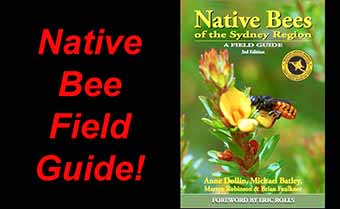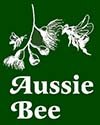NATIVE BEES OF THE SYDNEY REGION,
A FIELD GUIDE:
a review
Aussie Bee > Aussie Bee eBook Shop > Native Bees of the Sydney Region eBook > Native Bees of the Sydney Region Full Review
Sting in the Tale
Cheryl Maddocks
Good Weekend (Sydney Morning Herald),
17 November 2001
Next time I go into the garden, I'm putting on full protective gear. Every spring I get stung by a bee, and I am smarting at this very moment from the first sting of the season. If you want to attract bees to your garden, just invite me around. I'm also fair game for European wasps, spiders and centipedes.
As I was skirting around the lavender (site of the recent attack), I realised that apart from having cursed bees since I was a kid, I actually knew very little about them. So I acquired a copy of Native Bees of the Sydney Region. This small, informative book by A. Dollin, M. Batley, M. Robinson and B. Faulkner has just won the Whitley Award for the best field guide of 2001. Although the guide covers the area from Gosford to Wollongong and west to the Blue Mountains, many of the bee species described are found throughout Australia.

This book has completely changed the way I look at bees, especially as I discovered to my great relief that there are actually bees that don't sting. I also had no idea that there are 1,500 species of native bee in this country. One of them is the common teddy bear bee (Amegilla bombiformis) that looks a bit like a furry orange-brown bumblebee. The photograph of it reminded me of the cute large bumblebees I used to see in New Zealand as a child. The teddy bear bee's favourite foods are abelia and buddleia flowers, and at night it rests by clinging to a plant's stem by its jaws.
I also wrongly thought all bees were shades of brown, black and yellow. The neon cuckoo bee (Thyreus nitidulus) is a metallic black-and-blue. And, like other cuckoo bees, it is just as sneaky as a cuckoo bird. It slinks into the nests of other bees to lay its eggs, and its young then eat the provisions stored by the owner bee.
I also discovered buzz pollination, which is performed by some bees so that the anthers of certain flowers will freely release their pollen. "A buzz pollinator clings to the flower and vigorously vibrates its thorax, making a distinctive buzzing sound. The pollen shoots from the anther and is attracted back onto the bee's body by static electricity." How clever. Plants that are buzz pollinated include the Solanaceae family, flax lilies, Hibbertia scandens and borage.
What can you do as a gardener to help preserve our native bees and make gardens more bee-friendly? Insecticides kill beneficial insects like bees as well as killing pests, so a reduction in their use is a positive step. Urban development involving land clearing and landscaping can destroy bee colonies by removing nest sites and food supplies. Planting bee-attracting plants can help offset the effects of such development.
While some native bees will visit only native plants, others live happily among exotics, so a selection of native and exotic plants in the garden will be most beneficial to bees and other native wildlife. Given my recent painful experience, I wasn't surprised to read that lavender is listed in the book as one of the 10 best bee-attracting plants. The other nine are Abelia grandiflora, eucalyptus, baeckea, brachycome, buddleia, grevillea, Hardenbergia violacea, leptospermum and westringia.
Bees, especially short-tongued varieties (yes, there are short- and long-tongued bees) are attracted to plants in the Myrtaceae family. Bees are also attracted to the daisy family (Asteraceae), especially brachycome and our golden everlasting daisy (Bracteantha bracteata). They also like the flowers of culinary herbs such as basil, mint, thyme, sage, hyssop, lemon balm and savory. And stingless bees love citrus blossoms and the blossoms of boronia, correa, eriostemon and murraya.
Now that I know more about the subject, I am keen to examine bees more closely. Fully protected, of course.
(This article is reproduced here with the kind permission of Cheryl Maddocks)


